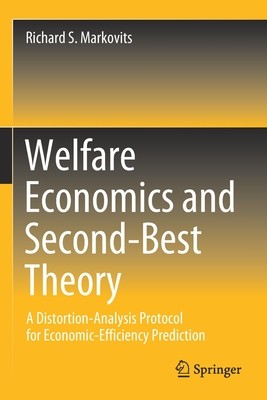
- We will send in 10–14 business days.
- Author: Richard S Markovits
- Publisher: Springer
- ISBN-10: 3030433625
- ISBN-13: 9783030433628
- Format: 15.6 x 23.4 x 2 cm, softcover
- Language: English
- SAVE -10% with code: EXTRA
Reviews
Description
This book examines the implications of The General Theory of Second Best for analyzing the economic efficiency of non-government conduct or government policies in an economically efficient way. It develops and legitimates an economically efficient economic-efficiency-analysis protocol with three unique characteristics: First, the protocol focuses separately on each of a wide variety of categories of economic inefficiency, many of which conventional analyses ignore. Second, it analyzes the impact of conduct or policies on each of these categories of economic inefficiency, primarily by predicting the respective conduct's/policy's impact on the distortion that the economy's various Pareto imperfections generate in the profits yielded by the resource allocations associated with the individual categories of economic inefficiency--i.e., on the difference between their profitability and economic efficiency. And third, it is third-best--i.e., it instructs the analyst to execute a theoretical or empirical research project if and only if the economic-efficiency gains the project is expected to generate by increasing the accuracy of economic-efficiency conclusions exceed the predicted allocative cost of its execution and public financing. The book also uses the protocol to analyze the economic efficiency of specific policies so as to illustrate both how it differs from the protocols that most applied welfare economists continue to use and how its conclusions differ from those produced by standard analysis.
EXTRA 10 % discount with code: EXTRA
The promotion ends in 9d.16:19:51
The discount code is valid when purchasing from 10 €. Discounts do not stack.
- Author: Richard S Markovits
- Publisher: Springer
- ISBN-10: 3030433625
- ISBN-13: 9783030433628
- Format: 15.6 x 23.4 x 2 cm, softcover
- Language: English English
This book examines the implications of The General Theory of Second Best for analyzing the economic efficiency of non-government conduct or government policies in an economically efficient way. It develops and legitimates an economically efficient economic-efficiency-analysis protocol with three unique characteristics: First, the protocol focuses separately on each of a wide variety of categories of economic inefficiency, many of which conventional analyses ignore. Second, it analyzes the impact of conduct or policies on each of these categories of economic inefficiency, primarily by predicting the respective conduct's/policy's impact on the distortion that the economy's various Pareto imperfections generate in the profits yielded by the resource allocations associated with the individual categories of economic inefficiency--i.e., on the difference between their profitability and economic efficiency. And third, it is third-best--i.e., it instructs the analyst to execute a theoretical or empirical research project if and only if the economic-efficiency gains the project is expected to generate by increasing the accuracy of economic-efficiency conclusions exceed the predicted allocative cost of its execution and public financing. The book also uses the protocol to analyze the economic efficiency of specific policies so as to illustrate both how it differs from the protocols that most applied welfare economists continue to use and how its conclusions differ from those produced by standard analysis.


Reviews